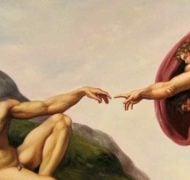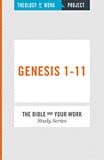People Are Created in God’s Image (Genesis 1:26, 27; 5:1)
Bible Commentary / Produced by TOW Project
Christopher Ziegler, "Live Out Loud: Work" |
Having told the story of God’s work of creation, Genesis moves on to tell the story of human work. Everything is grounded on God’s creation of people in his own image.
God said, “Let us make humankind in our image, according to our likeness.” (Gen. 1:26)
So God created humankind in his image, in the image of God he created them; male and female he created them. (Gen. 1:27)
When God created humankind, he made them in the likeness of God. (Gen. 5:1)
All creation displays God’s design, power, and goodness, but only human beings are said to be made in God’s image. A full theology of the image of God is beyond our scope here, so let us simply note that something about us is uniquely like him. It would be ridiculous to believe that we are exactly like God. We can’t create worlds out of pure chaos, and we shouldn’t try to do everything God does. "Beloved, never avenge yourselves, but leave room for the wrath of God; for it is written, ‘Vengeance is mine, I will repay, says the Lord’ " (Rom. 12:19). But the chief thing we know about God, so far in the narrative, is that God is a creator who works in the material world, who works in relationship, and whose work observes limits. We have the ability to do the same.
The rest of Genesis 1 and 2 develops human work in five specific categories: dominion, relationships, fruitfulness/growth, provision, and limits. The development occurs in two cycles, one in Genesis 1:26-2:4 and the other in Genesis 2:4-25. The order of the categories is not exactly in the same order both times, but all the categories are present in both cycles. The first cycle develops what it means to work in God’s image. The second cycle describes how God equips Adam and Eve for their work as they begin life in the Garden of Eden.
The language in the first cycle is more abstract and therefore well-suited for developing principles of human labor. The language in the second cycle is earthier, speaking of God forming things out of dirt and other elements, and is well suited for practical instruction for Adam and Eve in their particular work in the garden. This shift of language—with similar shifts throughout the first four books of the Bible—has attracted uncounted volumes of research, hypothesis, debate, and even division among scholars. Any general purpose commentary will provide a wealth of details. Most of these debates, however, have little impact on what the book of Genesis contributes to understanding work, workers, and workplaces, and we will not attempt to take a position on them here. What is relevant to our discussion is that chapter 2 repeats five themes developed earlier—in the order of dominion, provision, fruitfulness/growth, limits, and relationships—by describing how God equips people to fulfill the work we are created to do in his image. In order to make it easier to follow these themes, we will explore Genesis 1:26-2:25 category by category, rather than verse by verse. The following table gives a convenient index (with links) for those interested in exploring a particular verse immediately.
Passage (click to go to passage) |
Category (click to go to category) |
Cycle |
1 |
||
1 |
||
1 |
||
1 |
||
1 |
||
2 |
||
2 |
||
2 |
||
2 |
||
2 |
For an application of these passages, see "Help People Find their Gifts" at Country Supply Study Guide by clicking here.








